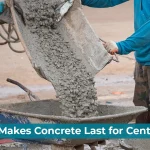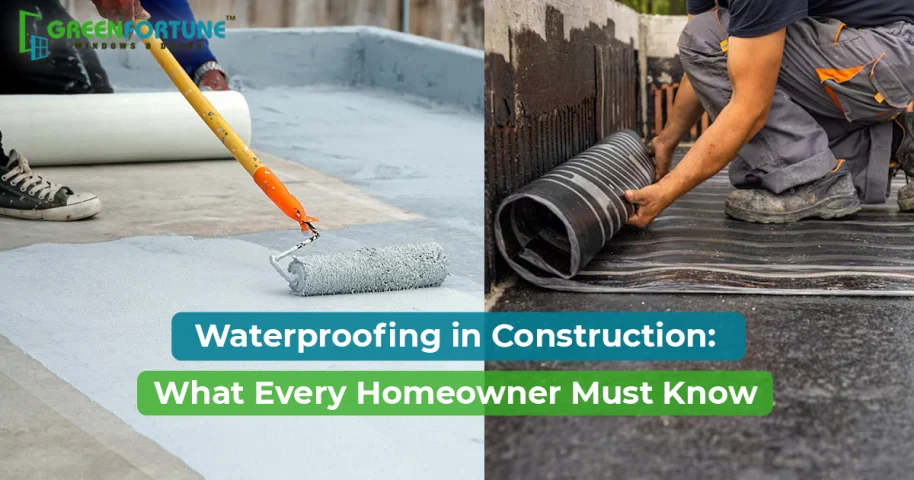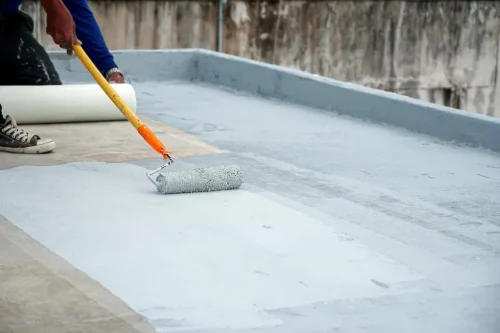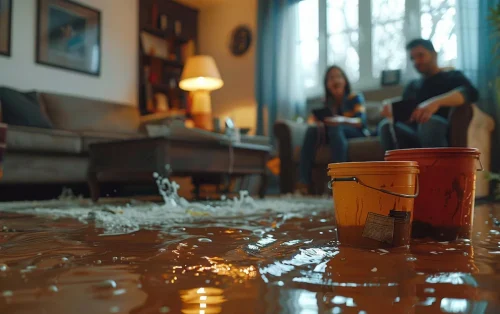
Discover the Bifold Doors Design for Modern Homes
April 30, 2025
From Fly Ash to Silica Fume: A Friendly Guide to Pozzolanic Materials in Concrete
May 2, 2025Table of contents
- What Does Waterproofing in Construction Mean?
- Importance of Waterproofing in Construction Plan
- Common Areas for Waterproofing in Construction of New Homes
- What Poor Waterproofing in Building Looks Like
- How is Waterproofing Work Done on Site
- Waterproofing Work Materials Every Homeowner Should Know
- Conclusion: Prevention is always the better option
- FAQs
Waterproofing in construction is a growing priority in the housing and real estate sector. With rising home prices and the high cost of interiors and repairs, homeowners are paying closer attention to what protects their investment. One of the most critical steps is keeping water out right from the start.
Still, many homes face issues like leaks, damp walls, and mold because waterproofing during the construction phase is skipped, rushed, or poorly executed. This blog breaks down what waterproofing in construction means. As water damage is not always visible early on, we’ll also discuss why it matters, where it’s needed, and what smart questions you should ask your builder before signing off.
What Does Waterproofing in Construction Mean?
Waterproofing in construction refers to all the steps taken to block water from getting into parts of the home where it doesn’t belong. Including waterproofing in construction of basements, bathrooms, roofs, and even balconies requires special materials and coatings to ensure walls, floors, and joints don’t absorb or leak moisture over time.
The goal is to make sure those leaks never happen in the first place.
Importance of Waterproofing in Construction Plan
The main importance of waterproofing in construction is to prevent water damage, mold, and deterioration. Without proper waterproofing, issues like peeling paint or black mold can emerge, signaling that the damage has already set in. Here’s why waterproofing should be part of the construction plan from Day One:
- It protects the structural integrity of the building by keeping concrete and walls dry.
- It helps prevent long-term repair costs from water-related damage.
- It safeguards from damage to expensive interior finishes like paint, tiles, and woodwork.
- It creates a healthier living environment by reducing dampness and mold growth.
- It improves the overall value and lifespan of the property.
Common Areas for Waterproofing in Construction of New Homes
Key areas for waterproofing in new homes include those exposed to water or with limited sunlight for drying. These parts of the home must be waterproofed during the construction phase, before any finishing work begins:
- Roofs, especially flat ones, must be waterproofed because rainwater can easily collect and seep through if left untreated.
- Bathrooms and kitchens require strong waterproofing due to constant contact with water and steam during daily use.
- Basements should be sealed properly to prevent water seepage from underground, which is a common cause of damp walls.
- Terraces and balconies need special coatings to avoid water pooling and slowly damaging the surface below.
- External walls must be protected to handle exposure to harsh weather, including storms, wind-driven rain, and long periods of moisture.
What Poor Waterproofing in Building Looks Like
When waterproofing in building projects isn’t done right, the damage might not show up right away. But over time, the signs become clear and often expensive to fix:
- You may notice patches of dampness on ceilings and walls, especially after heavy rains.
- Corners of rooms or closets can develop a moldy smell and dark spots due to trapped moisture.
- White, powdery deposits called efflorescence may form on brick or concrete surfaces as water brings salts to the surface.
- Floor tiles may become loose, or wood flooring might start to swell or buckle as moisture seeps underneath.
- Rust marks can appear around window frames or door edges where metal has been exposed to moisture for too long.
How is Waterproofing Work Done on Site
Waterproofing work begins after the main structure of the home is ready. Different parts of the house require different materials and techniques depending on the surface and exposure to water. Contractors typically follow a step-by-step process:
- The surface is first cleaned thoroughly to remove any dust, grease, or loose debris.
- Any cracks or joints are filled using appropriate sealants to create a solid base.
- A primer is applied to improve the bond between the surface and the waterproofing material.
- The main waterproofing layer is then applied, which may involve membranes, coatings, or flexible compounds.
- Once dry, the area is given a protective finish such as tiling, screeding, or plastering to secure the seal.
Waterproofing Work Materials Every Homeowner Should Know
Here are the most commonly used waterproofing membrane materials during construction and where they’re typically used:
- Cement-based coatings are commonly used on wet walls and basement interiors because they’re easy to apply and bond well with concrete.
- Bituminous membranes are popular for roofs and terraces as they create a strong, water-resistant layer that lasts for years.
- Liquid membranes work best on uneven or hard-to-reach surfaces where traditional sheets may not fit properly.
- Sheet membranes are used on large flat areas like terraces or foundation slabs where a uniform layer is needed.
- Polyurethane sealants provide a flexible, high-performance solution, especially useful in areas where surfaces may expand or contract.
Conclusion: Prevention is always the better option
Quality waterproofing work adds years to your home’s life, protects your budget, and saves you from the stress of fixing what would have easily been prevented.
While waterproofing protects your walls, uPVC window frames and doors offer another layer of water resistance. Check out all the options from Greenfortune.
FAQs
- Can I waterproof my home after construction is complete?
Yes, post-construction waterproofing is possible, but it’s usually more expensive and less effective than doing it during construction because it often involves breaking finished surfaces like tiles or walls to fix problem areas. - Is waterproofing covered under builder warranties?
It depends on your contract. Some builders include waterproofing under structural warranties for a limited period (usually 5 to 10 years). Always check the warranty documents carefully and ask what’s covered and what’s not. - How can I check if waterproofing has been done correctly?
Ask for photos or site visit updates during construction. ask your builder which materials they’re using and why. If the answer feels rushed or unclear, don’t hesitate to ask until you are sure. If possible, hire a third-party inspector to check key areas like the roof, basement, and bathrooms before interior work begins. - Are waterproofing chemicals safe for indoor spaces?
Most modern waterproofing materials are safe once cured. However, during application, proper ventilation and safety gear are a must. If you're sensitive to fumes or have small kids or pets around, talk to your contractor about low-VOC or eco-friendly options.









